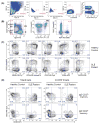OMIP-003: phenotypic analysis of human memory B cells
- PMID: 21796774
- PMCID: PMC3199331
- DOI: 10.1002/cyto.a.21112
OMIP-003: phenotypic analysis of human memory B cells
Figures

References
-
- Wei C, Anolik J, Cappione A, Zheng B, Pugh-Bernard A, Brooks J, Lee E-H, Milner ECB, Sanz I. A New Population of Cells Lacking Expression of CD27 Represents a Notable Component of the B Cell Memory Compartment in Systemic Lupus Erythematosus. J Immunol. 2007;178(10):6624–6633. - PubMed
-
- Jacobi AM, Reiter K, Mackay M, Aranow C, Hiepe F, Radbruch A, Hansen A, Burmester GR, Diamond B, Lipsky PE, et al. Activated memory B cell subsets correlate with disease activity in systemic lupus erythematosus: delineation by expression of CD27, IgD, and CD95. Arthritis Rheum. 2008;58(6):1762–73. - PubMed
MeSH terms
Substances
Grants and funding
LinkOut - more resources
Full Text Sources

